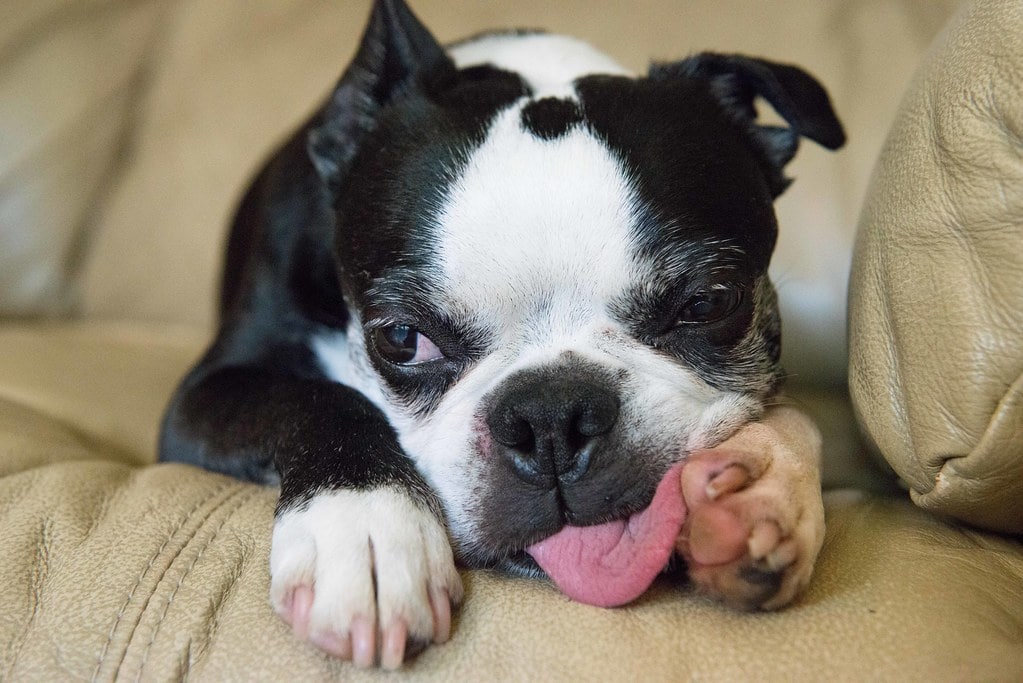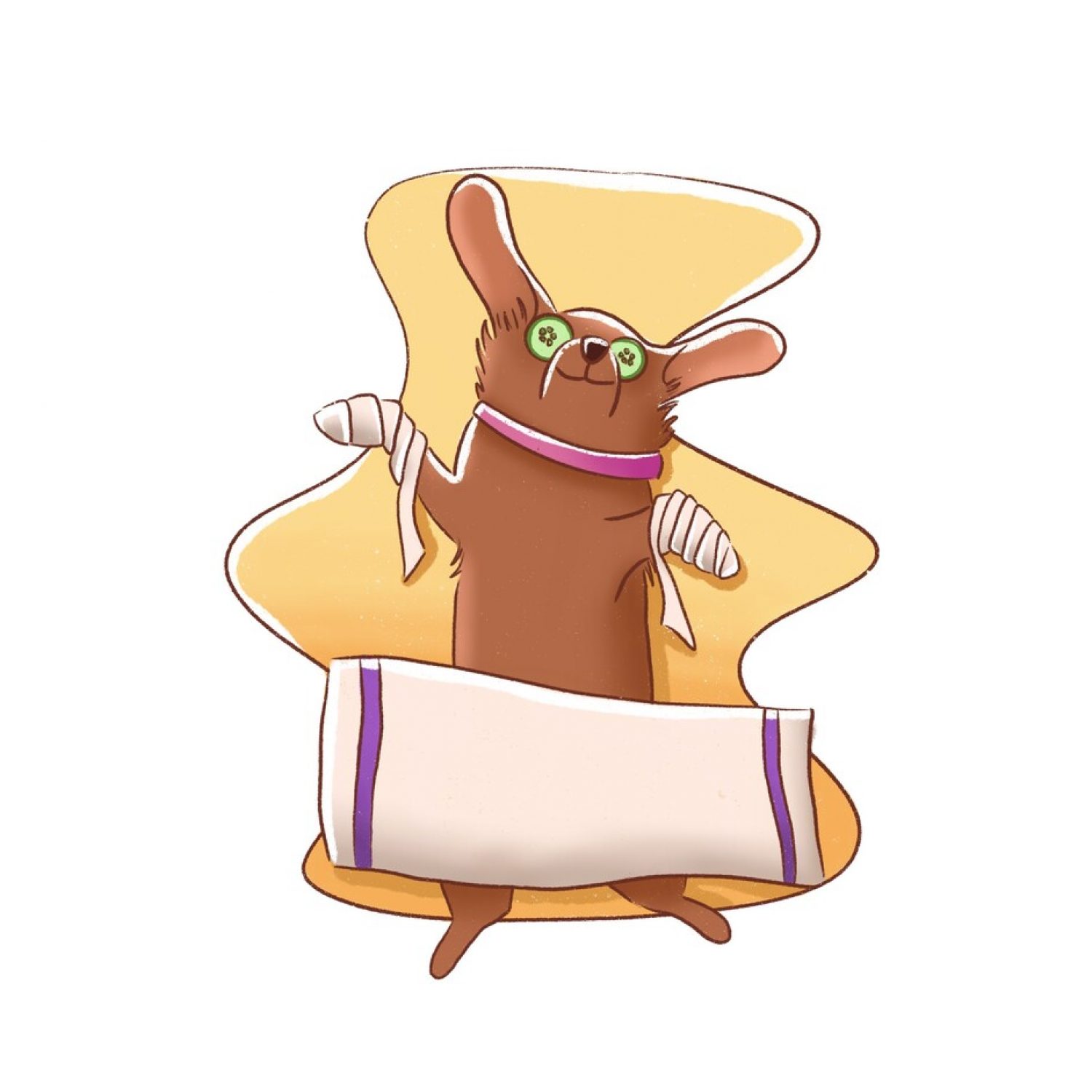Paw licking is typically viewed as a harmless exercise that most species of animals practice, and the common thought associated with it is that it is a remedy for dry skin. While this is true, it is also a bit misleading since a plethora of ailments could follow this routine. Just like you and I, a dog opens itself up to danger when wounds are neglected or ignored altogether. When your companion is paying attention to its paws, an innumerable number of factors could be in play, many of which are vital to their overall well-being.

Signs To Look Out For
Excessive licking (until the skin is red, inflamed or even raw) is obviously the first telltale sign that you are dealing with something more problematic as a pet owner, but this does not necessarily mean an issue is afoot (pun intended). When a dog tends to its paws, often times this is a behavioral activity that derives from any number of things including boredom, anxiety or simply standard grooming. An initial troublesome occurrence is to pay attention to not just if they are licking their pads constantly, but WHEN. After a walk or run, if they are immediately coating their skin in saliva, it is a good bet something is going on.
Swelling and discoloration are also markers that licking is much more than just instinct. Because dogs are on their paws 24/7, they literally represent their livelihood. This is why grooming this area is of prime importance, but as their guardian it is up to you to witness unusual signals. Another such occurrence is more hair loss than normal. In most canines losing follicles is a part of life, however if it is out of nowhere, inspect the area thoroughly and be mindful of how much attention your pup is paying to it.
Hyperkeratosis (Dry Skin) or Allergies
Perhaps the most common ailment that coincides with frequent licking of the paws by your canine is hyperkeratosis. While the name may sound intimidating, it is essentially an abnormality in the skin. Similar to humans, dogs produce a protein called keratin. On our bodies this provides us a protective layer against the elements, and this is no different for our pets.
The difference is it is more important to our friendly counterparts than us because they do not have the means or wherewithal to protect themselves. Hyperkeratosis is the process of too much keratin building up to the point that the paw is negatively altered. While in theory more keratin sounds like a good thing, in actuality it causes irritation and redness. It is an unnatural state for paws to be in, and when you weigh this along with the fact that dogs are always on their feet, it is easy to see how this can be worrisome. These thick layers are prone to infection because cracking will eventually be the result, if not full blown sores.
Like anything bothering a dog, saliva and licking the affected areas will soon follow. This is not ideal for animals with hyperkeratosis for numerous reasons. To begin with, the cross transfer of harmful agents from mouth to foot, or vice versa, can cause your pets to get nauseous and have trouble keeping food down. It is particularly relevant to older breeds that no longer have the immune system to ward off potential diseases. Since dry skin is a given when hyperkeratosis is present, undoubtedly your furry companion has already attempted to moisten its paws. Several owners make the mistake of assuming that the wetness a dog’s tongue provides is enough to satiate an infected paw. Nothing could be further from the truth, as this is a temporary solution, and one that depends entirely on the dog having no preexisting health conditions.
Because hyperkeratosis eradicates moisture from paws, they are much more likely to get them sunburned or even cut by the snow and ice of unforgiving winters. Additionally, it causes paws to become easy targets of allergies from pollen to types of food to chemical agents found in floor cleaners; among other things. This is because hyperkeratosis allows harmful bacteria to flourish. While excessive licking of feet here and there might seem to keep these issues at bay, it is like putting a band-aid on a bullet hole. Eventually keratin production will win out if left untreated.
Arthritis Or Pain
Of course every time a dog sticks a paw in their mouth is not cause for panic, however bear in mind this could be communicating to you the onset of something very serious, such as arthritis. Even if a dog’s age or behavior dictates this is not the case, it is prudent to check their extremities and belly immediately to see if they are in pain in some way. The reason animals lick their feet repeatedly if they are injured is because it is their method of keeping calm and providing some comfort to their temperament. It is stating the obvious that the two are not mutually exclusive, but especially if it is out of character for your pup to engage in this activity, you should be mindful of why he/she is performing this type of grooming. The contours of a dog’s tongue can wipe away blood or unwanted debris, but very rarely clean a wound. The mouth of a canine is full of bacteria and not a sustainable method to address any pain, let alone arthritis.
Yeast Infections
It is a myth that all yeast infections in dogs occur on their ears, as it is a very real issue on paws as well. Just like arthritis and hyperkeratosis, your companion will moisten the pads if it is present. It is sometimes difficult to differentiate yeast infections or hyperkeratosis as the cause behind frequent licking, since they both involve inflammation. One way to do so is that if your dog is suffering from something yeast related, it is a good bet it is on other parts of his or her body as well, and not just limited to feet. This infection category also releases a discharge on occasion that is sticky and can leave small streaks on flooring.
Some Tips To Help
There are a few things you can do as a concerned owner to begin to rectify cracked paws (and the accompanying licking), beginning with a frequent rotation of fresh water dishes. That being said, this will not prevent dry skin or hyperkeratosis, but rather slow their impact.
The pH levels in a dog’s feet are paramount to how healthy they are, and a light baking soda or oatmeal bath can provide some initial comfort to rough, damaged pads. It should be noted that when an animal’s pH spikes, this does not mean that complete healing has taken place. They are tactics to produce an anti-inflammatory response, but not a full-blown solution.
If your worry carries you beyond home remedies, it is never a bad choice to touch base with your veterinarian and see what advice works best for you moving forward. However, dry, cracked or even excessively irritated paws can be swiftly cured yourself with the appropriate option by your side.
How To Stop Your Dog From Constantly Licking Its Paws – Natural Treatment
The truth of the matter is regardless of whether or not your dog is experiencing symptoms, it is wise to have a form of protection on their paws year round. The reality is our feet do not suffer a fraction of the wear and tear a dog’s does, and if nothing else it provides an outer layer to battle against potential infection.
 The most advisable solution is the repeated use of our Paws and Snout Premium Protection Balm, for a multitude of reasons. A completely natural solution, it is a collection of premium ingredients that will not cause further harm and potentially open your dog up to an allergic reaction that competing brands often do. Paws and Snout Premium is a balm that is effective 365 days a year no matter the climate and types of terrain your dog encounters. This makes it a logical, intelligent remedy regardless of where you are on the globe. Its bread and butter are its integral use of vitamins A, E, and F.
The most advisable solution is the repeated use of our Paws and Snout Premium Protection Balm, for a multitude of reasons. A completely natural solution, it is a collection of premium ingredients that will not cause further harm and potentially open your dog up to an allergic reaction that competing brands often do. Paws and Snout Premium is a balm that is effective 365 days a year no matter the climate and types of terrain your dog encounters. This makes it a logical, intelligent remedy regardless of where you are on the globe. Its bread and butter are its integral use of vitamins A, E, and F.
This is an incredible trio that soothe, protect, and heal in a way that is non-invasive to your companion. The organic shea butter utilized in the solution is one of most effective ingredients that will not cause your pets to get sick if ingested, even if your dog needs to be weaned off of excessive paw licking.
Providing moisture and comfort to the snout as well as paws, promoting soft skin, eliminating chapped pads, and relieving symptoms of infection are just a few proponents of its use. It substantially aids in the closing of a wound and is helpful in the fading of scars and alleviating any pain your loved one is experiencing.
It is the quintessential solution that is a must for all dog owners devoted to maximum quality of life for their pet.

